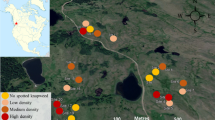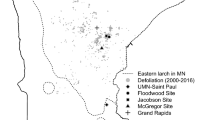Summary
A hypothesis originally postulated to explain changes in abundance of sapsucking insects is here extended to an interpretation of changes in abundance of populations of geometrid defoliators.
The hypothesis states that most herbivorous insects usually remain at a low level of abundance relative to the apparent abundance of their food because most of them die when very young from a relative shortage of nitrogen in their food.
Only occasionally do their food plants become a sufficient source of nitrogen to allow a high proportion of the young insects to survive, and the population to increase to outbreak levels.
The plants become a richer source of nitrogen when they are stressed by random fluctuations in the summer and winter rainfall, although other factors such as soil type and topography may contribute to this stress.
The hypothesis may well have wider application to population fluctuations of other herbivores—both invertebrate and vertebrate.
Similar content being viewed by others
References
Andrewartha, H. G.: Introduction to the study of animal populations, 2nd ed. London: Methuen 1970
Barnett, N. M., Naylor, A. W.: Amino acid and protein metabolism in Bermuda grass during water stress. Pl. Physiol. (Lancaster) 41, 1222–1230 (1966)
Bates, T. E.: Factors affecting critical nutrient concentrations in plants and their evaluation: a review. Soil Sci. 112, 116–130 (1971)
Chen, D., Kessler, B., Monselise, S. P.: Studies on water regime and nitrogen metabolism of citrus seedlings grown under water stress. Pl. Physiol. (Lancaster) 39, 379–386 (1964)
Ebell, L. F.: Cone production induced by drought in potted Douglas Fir. Can. For. Serv. Bimonthly Res. Notes 23, 26–27 (1967)
Ebell, L. F.: Girdling: its effect on carbohydrate status and on reproductive bud and cone development of Douglas Fir. Canad. J. Bot. 49, 453–466 (1971)
Fauss, D. L., Pierce, W. R.: Stand conditions and Spruce budworm damage in a western Montana forest. J. For. 67, 322–325 (1969)
Fennah, R. G.: Nutritional factors associated with seasonal population increase of Cacao thrips, Selenothrips rubrocinctus (Giard) (Thysanoptera), on Cashew, Anacardium occidentale. Bull. ent. Res. 53, 681–713 (1963)
Foltz, J. L., Knight, F. B., Allen, D. C.: Numerical analysis of population fluctuations of the Jack Pine Budworm. Ann. ent. Soc. Amer. 65, 82–89 (1972)
Furniss, M. M., Barr, W. F.: Bionomics of Anacamptodes clivinaria profanata (Lepidoptera: Geometridae) on Mountain Mahogany in Idaho. Univ. of Idaho College of Agric. Res. Bull. 73, 1–24 (1967)
Gordon, L. Kh.: Dependence on the state of water in wheat roots on their nitrogen metabolism. Soviet Pl. Physiol. 11, 389–393 (1964)
Hashizume, H.: Experimental induction of female flowers in young Japanese larch (Larix leptolepis). J. Jap. For. Soc. 49, 405–408 (1967)
Hepburn, G. A., Loedolff, J.: A new forest pest in South Africa (Neocleora herbuloti Fletcher, order Lepidoptera, family Geometridae). Forestry in South Africa 4, 1–18 (1964)
Holmsgaard, E., Olsen, H. C.: The effect of weather on the production of Beech mast (in Danish). Forstl. Forsøgso. Danm. 26, 345–370 (1960)
House, H. L.: Effects of low levels of the nutrient content of a food and of nutrient imbalance on the feeding and the nutrition of a phytophagous larva, Celerio euphorbiae (L.) (Lepidoptera: Sphingidae). Canad. Ent. 97, 62–68 (1965)
Kear, B. S., Gibbs, H. S., Miller, R. B.: Soils of the Downs and Plains Canterbury and North Otago New Zealand. N. Z. D.S.I.R. Soil Bureau Bull. 14, 1–92 (1967)
Kemble, A. R., MacPherson, H. T.: Liberation of amino acids in perennial ryegrass during wilting. Biochem. J. 58, 46–49 (1954)
Kimmins, J. P.: Variations in the foliar amino acid composition of flowering and non-flowering balsam fir [Abies balsamea (L.) Mill.] and white spruce [Picea glauca (Moench) Voss] in relation to outbreaks of the spruce budworm [Choristoneura fumiferana (Clem.)]. Canad. J. Zool. 49, 1005–1011 (1971)
Klomp, H.: A seventeen-year study of the abundance of the Pine Looper, Bupalus piniarius L. (Lepidoptera: Geometridae). Roy. ent. Soc. Lond. Symp. 4, 98–108 (1968)
Kozlowski, T. T.: Water metabolism in plants. New York: Harper & Row 1965
Kozlowski, T. T.: Water deficits and Plant growth. III. Plant responses and control of water blance. New York-London: Academic Press 1972
Leibholz, J.: The effects of starvation and low nitrogen intakes on the concentration of free amino acids in the blood plasma and on the nitrogen metabolism in sheep. Aust. J. agric. Res. 21, 723–734 (1970)
Ludwig, D., Wugmeister, M.: Effects of starvation on the blood of Japanese beetle (Popillia japonica Newman) larvae. Physiol. Zool. 26, 254–259 (1953)
Mathews, J. D.: Factors affecting the production of seed by forest trees. For. Abstr. 24, i-xiii (1963)
Mitchell, C., Mitchison, I.: Windblown Sitka spruce. Quart. J. For. 44, 149–150 (1950)
Morris, R. F.: The dynamics of epidemic Spruce Budworm populations Mem. ent. Soc. Can. 31, 1–322 (1963)
Prior, K. W.: Wind damage to exotic forests in Canterbury. N. Z. J. For. 8, 57–68 (1959)
Rawlings, G. B.: Insect epidemics on forest trees in New Zealand. N. Z. J. For. 6, 405–412 (1953)
Rawlings, G. B.: Epidemics in Pinus radiata forests in New Zealand. N. Z. J. For. 7, 53–55 (1955)
Saunier, R. E., Hull, H. M., Ehrenreich, J. H.: Aspects of the drought tolerance in creosotebush (Larrea divaricata). Pl. Physiol. (Lancaster) 43, 401–404 (1968)
Shah, C. B., Loomis, R. S.: Ribonucleic acid and protein metabolism in sugar beet during drought. Physiologia Pl. 18, 240–254 (1965)
Shaw, G. C., Little, C. H. A.: Effects of high urea fertilization of Balsam Fir trees on Spruce Budworm development. In: Insect and mite nutrition, p. 589–597. Amsterdam: North Holland 1972
Todd, G. W., Vick, P., Tsai, Sing-Dao: Some further observations on protein fractions isolated from wheat leaves subjected to moisture stress. Proc. Okla. Acad. Sci. 50, 106–109 (1970)
Vasu, B. S., Giese, A. C.: Protein and non-protein nitrogen in the body fluid of Pisaster ochraceous (Echinodermata) in relation to nutrition and reproduction. Comp. Biochem. Physiol. 19, 351–361 (1966)
Wellington, W. G.: Population quality and the maintenance of nuclear polyhedrosis between outbreaks of Malacosoma pluviale (Dyer). J. Insect Path. 4, 285–305 (1962)
Wendelken, W. J.: Root development and wind firmness on the shallow gravel soils of the Canterbury Plains. N. Z. J. For. 7, 71–76 (1955)
Wendelken, W. J.: Eyrewell Forest: A search for stable management. N. Z. J. For. 11, 43–65 (1966)
White, T. C. R.: Forest biology survey in New Zealand. N. Z. Timb. J. 4, 38–40 (1957)
White, T. C. R.: Food and outbreaks of phytophagous insects. Ph. D. thesis, University of Adelaide, p. 1–261 (1966)
White, T. C. R.: An index to measure weather-induced stress of trees associated with outbreaks of psyllids in Australia. Ecology 50, 905–909 (1969)
White, T. C. R.: Some aspects of the life history, host selection, dispersal and oviposition of adult Cardiaspina densitexta (Homoptera: Psyllidae). Aust. J. Zool. 18, 105–117 (1970a)
White, T. C. R.: The nymphal stages of Cardiaspina densitexta (Homoptera: Psyllidae) on leaves of Eucalyptus fasciculosa. Aust. J. Zool. 18, 273–293 (1970b)
White, T. C. R.: Lerp Insects (Homoptera, Psycllidae) on Red Gum (E. camaldulensis) in South Australia. S. A. Nat. 46, 20–23 (1971)
White, T. C. R.: The establishment, spread and host range of Paropsis charybdis Stäl (Chrysomelidae) in New Zealand. Pacif. Insects 15, 59–66 (1973)
White, T. C. R.: A quantitative method for sampling larvae of Selidosema suavis Butler (Lepidoptera: Geometridae) in plantations in New Zealand. Canad. Ent. (in press)
Wickman, B. E., Hunt, R. H.: Biology of the Phantom Hemlock Looper on Douglas-fir in California. J. econ. Ent. 62, 1046–1050 (1969)
Author information
Authors and Affiliations
Rights and permissions
About this article
Cite this article
White, T.C.R. A hypothesis to explain outbreaks of looper caterpillars, with special reference to populations of Selidosema suavis in a plantation of Pinus radiata in New Zealand. Oecologia 16, 279–301 (1974). https://doi.org/10.1007/BF00344738
Received:
Issue Date:
DOI: https://doi.org/10.1007/BF00344738




